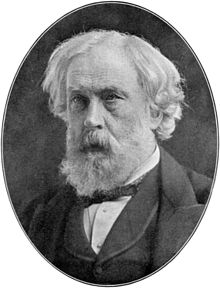Samuel Wilks
Sir Samuel Wilks, Bt | |
|---|---|
 | |
| Born | 2 June 1824 |
| Died | 8 November 1911 (aged 87) |
| Nationality | British |
| Alma mater | Guy's Hospital |
| Scientific career | |
| Fields | medicine |
Sir Samuel Wilks, 1st Baronet, FRS, FRCP (2 June 1824 – 8 November 1911) was a British physician and biographer.
Early life
Samuel Wilks was born on 2 June 1824 in Camberwell, London, the second son of Joseph Barber Wilks, a cashier at the East India House. After attending Aldenham School and University College School he was apprenticed to Richard Prior, a doctor in Newington.[1]
Career
In 1842 he entered Guy's Hospital to study medicine. After graduating MB in 1848 he was hired as a physician to the Surrey Infirmary (1853). In 1856 he returned to Guy's Hospital, first as assistant physician and curator of its museum (a post he held for nine years), then as physician and lecturer on medicine (1857). From 1866 to 1870 he was examiner in the practice of medicine at the University of London and from 1868 to 1875 examiner in medicine at the Royal College of Surgeons.
Achievements

Among his major discoveries, Wilks recognised ulcerative colitis in 1859, differentiating it from bacterial dysentery. His work was confirmed later (1931) by Sir Arthur Hurst.[2] Wilks's autopsy of a 42-year-old woman who died after several months of diarrhoea and fever demonstrated a transmural ulcerative inflammation of the colon and terminal ileum.
Wilks also firstly described trichorrhexis nodosa (the formation of nodes along the hair shaft), in 1852. The term was proposed in 1876 by Moritz Kaposi (1837–1902), a Hungarian dermatologist. In 1957, he provided the first autopsy description of a condition of the upper airways, later known as tracheobronchopathia osteochondroplastica.[3] Subsequently, in 1868, he published the characteristic mental symptoms on alcoholic paraplegia (later to be named Korsakoff's syndrome). Wilks described the first case of myasthenia gravis, in 1877 (it was named "bulbar paralysis" in Guy's Hospital Reports 22:7).
He was a collaborator and biographer of the "Three Great", contemporary physicians who worked at Guy's Hospital, Dr. Thomas Addison, the discoverer of Addison's disease, Dr. Richard Bright, discoverer of Bright's disease and Dr. Thomas Hodgkin, discoverer of Hodgkin's lymphoma. After the death of Addison in 1860, he carried out the job of examining specimens from all over the country in order to confirm the diagnosis of Addison's disease and thus was able to amass a large case archive. He also rediscovered and confirmed the existence of Hodgkin's lymphoma, at the same time recognizing Hodgkin's priority and proposing the eponym.
Honours and awards

Among his many services and honors, Wilks was elected a Fellow of the Royal Society in June 1870;[4] was president of the Pathological Society (1881–1882); president of the Neurological Society (1887); member of the Senate of the University of London (1887–1900); member of the General Medicine Council (1887–1896) and president of the Royal College of Physicians (1896–1899). He was named Physician Extraordinary to Queen Victoria in 1897. The following year he was created a baronet, of Grosvenor Street in the Parish of Saint George Hanover Square in the County of London.
Later life
In later life he suffered a stroke and was terminally paraplegic. He died aged 87 at his home in Hampstead on 8 November 1911. After his death the baronetcy became extinct. He had married Mrs. Elizabeth Anne Prior, widow of previous employer Richard Prior; they had no children.
Publications
- Lectures on Pathological Anatomy, 1869
- Lectures on the Specific Fevers and on Diseases of the Chest, 1874
- Lectures on Diseases of the Nervous System, 1878
- Lectures on Pathology Delivered at the London Hospital. J & A Churchill, London, 1891.
- A Biographical History of Guy's Hospital, 1892 (with G. T. Bettany)
- The Relation of Man to the Animal World (1907)
References
- ^ Sir Samuel Wilks (1824–1911): ‘The Most Philosophical of English Physicians’. Content.karger.com. Retrieved 2012-05-21.
- ^ Hurst, Arthur F. (1931). "A paper on ulcerative colitis". British Medical Journal. 1 (3668): 693–694. doi:10.1136/bmj.1.3668.693. PMC 2314866. PMID 20776135.
- ^ Wilks, Samuel (1857). "Ossific deposits on larynx, trachea and bronchi". Trans. Path. Soc. Lond. 8: 88.
- ^ "Library and Archive Catalogue". The Royal Society. Retrieved 30 October 2010.[permanent dead link]
Leigh Rayment's list of baronets
- Kauntze R.: Samuel Wilks. Guy's Hosp Rep. 1970; 119(4):353-5.
- Eadie, Mervyn J (2008). "Samuel Wilks (1824–1911): neurologist and generalist of the Mid-Victorian Era". Journal of Medical Biography. 16 (4): 215–20. doi:10.1258/jmb.2007.007042. PMID 18952992. S2CID 22797053.
